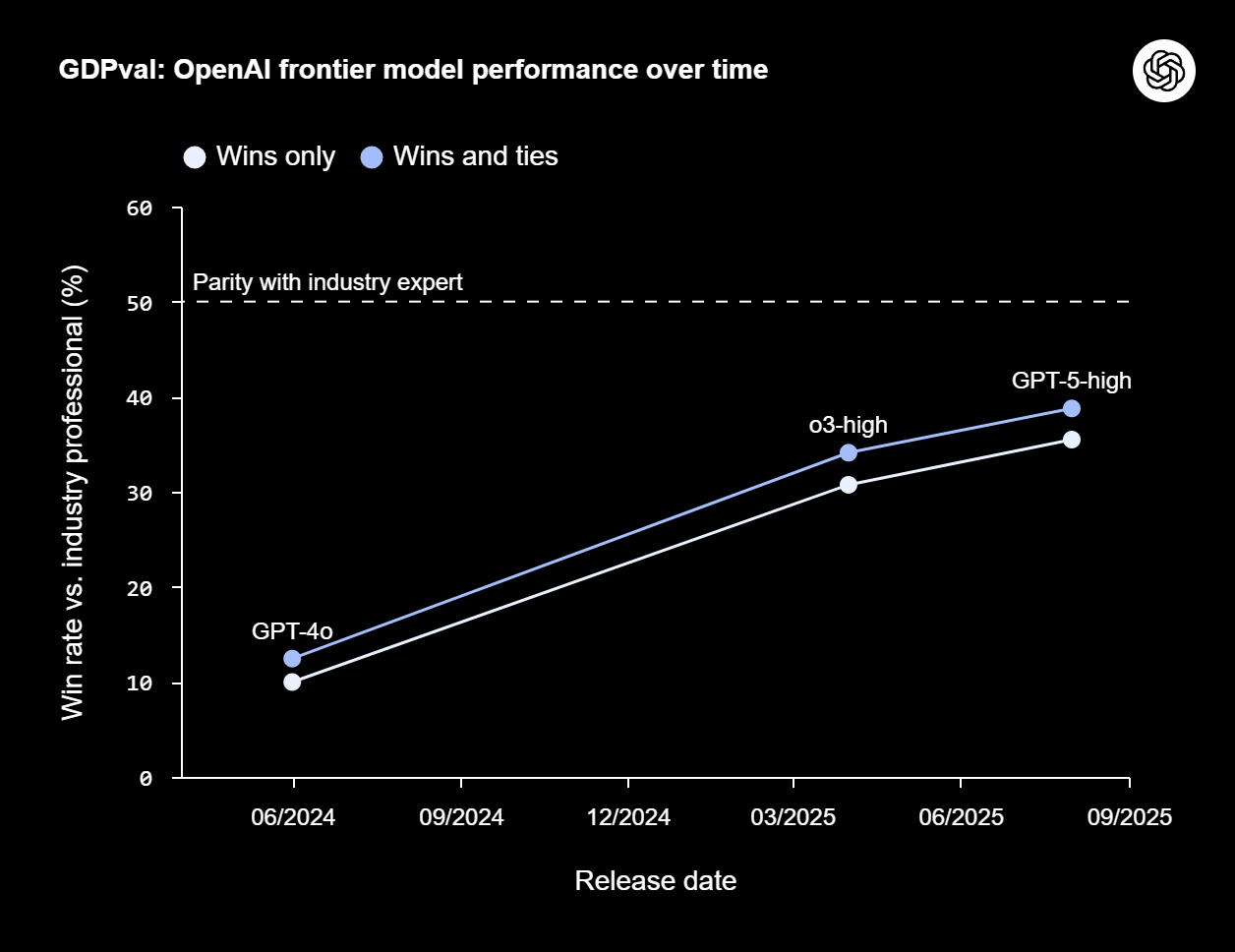OpenAI’s new initiative, GDPval, aims to provide a clear, evidence-based measure of how AI models perform on real-world, economically valuable tasks. Artificial intelligence is no longer confined to academic labs, it is actively reshaping knowledge work and the broader economy. By evaluating AI’s effectiveness on tasks that mirror professional deliverables, GDPval challenges traditional benchmarking and offers a glimpse into how we might redefine productivity in the era of artificial intelligence.
GDPval: A New Lens on Economic Measurement
GDPval takes inspiration from Gross Domestic Product (GDP), a foundational economic metric, but shifts the focus to tasks that matter most in the workplace. Instead of academic exercises, it assesses AI models on 1,320 specialized tasks across 44 occupations in the top nine U.S. GDP-contributing industries.
Each task is designed and validated by experts with significant industry experience, ensuring the scenarios closely resemble daily professional work. Deliverables range from legal briefs and engineering diagrams to customer support transcripts, highlighting the diversity and authenticity of the tasks evaluated.
- Real-world relevance: Tasks reflect what professionals actually do and require outputs beyond simple text responses.
- Expert-driven design: Each scenario is crafted by industry veterans to ensure authenticity and rigor.
- Broad coverage: The focus spans industries and occupations central to the U.S. economy, maximizing practical impact.
Choosing Tasks That Matter
GDPval’s selection process centers on where AI can make the greatest economic impact: knowledge-driven industries and roles. OpenAI analyzed wage, employment, and occupational data from authoritative sources like the U.S. Bureau of Labor Statistics and O*NET.
Only industries contributing over 5% of the U.S. GDP were considered, and within each, key occupations (such as software developers, lawyers, nurses, and financial analysts) were selected based on their prevalence and economic output. This ensures the dataset targets roles where AI’s influence is likely to be most profound.
- Industry relevance and scale drive occupation selection.
- Five major knowledge work roles are chosen per industry for comprehensive coverage.
- Examples include both technical and non-technical professions, reflecting the broad scope of AI’s reach.
Building a Robust and Reliable Dataset
To guarantee meaningful evaluation, GDPval relies on tasks designed and reviewed by seasoned professionals. Each task undergoes a multi-stage vetting process to ensure clarity, feasibility, and alignment with real-world work. For every occupation, 30 tasks represent the full spectrum of job responsibilities, with a subset open for research use.
Performance evaluation is rigorous: blind peer reviews by experts compare AI outputs to those from humans, using detailed grading rubrics for fairness and consistency. While an experimental AI-based grader can forecast expert preferences, human judgment remains the benchmark for quality and accuracy.

Expert graders compared deliverables from leading models to human experts. Today’s frontier models are already approaching the quality of work produced by industry experts. Claude Opus 4.1 produced outputs rated as good as or better than humans in just under half the tasks. Credit: OpenAi

From GPT‑4o to GPT‑5, performance on GDPval tasks more than tripled in a year. Credit: OpenAI
What the Results Reveal About AI’s Economic Potential
Initial findings are compelling with top AI models already performing at or above the level of industry experts on nearly half the evaluated tasks. For example, Claude Opus 4.1 excelled in producing aesthetically pleasing deliverables, while GPT-5 led in technical accuracy. The performance leap from GPT-4o to GPT-5 in just a year underscores the rapid pace of progress.
Equally striking are the gains in speed and cost: AI can complete tasks up to 100 times faster and cheaper than humans, opening the door to significant productivity boosts. However, these measures don’t fully account for the need for human oversight and seamless integration into real-world workflows.
- Model strengths: Different models shine in different areas, some in quality, others in domain expertise.
- Efficiency breakthroughs: AI slashes the time and cost of knowledge work, hinting at shifts in economic valuation.
- Continuous progress: Iterative improvements and richer training data are steadily lifting model performance.
Recognizing the Limits and Looking Ahead
Despite its advances, GDPval is not without constraints. It currently assesses single-task scenarios, missing the iterative, often collaborative nature of real jobs. Future versions aim to expand into more industries, introduce interactive tasks, and better reflect the complex realities of workplace problem-solving. OpenAI is also seeking partnerships with industry experts and organizations to make GDPval more representative and actionable for economic policy and workforce strategy.
Final Thoughts: Reimagining Productivity in the AI Era
GDPval signals a paradigm shift in how we assess the economic value of AI. By directly measuring impact on meaningful work, it moves the conversation from speculation to substantiated evidence. As AI continues to augment human capabilities, the metrics we use to value labor and productivity may need to evolve. With collaborative frameworks and transparent evaluation, the benefits of AI-driven growth can be more widely shared in the new economic landscape.
- If you’re an industry expert interested in contributing to GDPval, please show your interest here.
- If you’re a customer working with OpenAI and you'd like to contribute to a future round of GDPval, please express interest here.
Source: OpenAI Blog

OpenAI’s GDPval Is Changing the Way We Measure AI’s Economic Impact